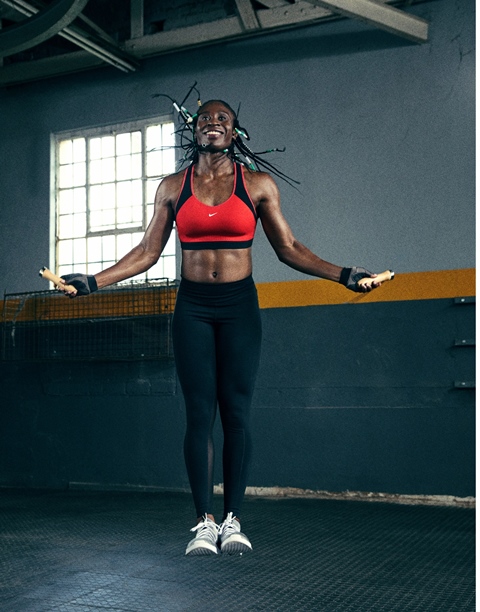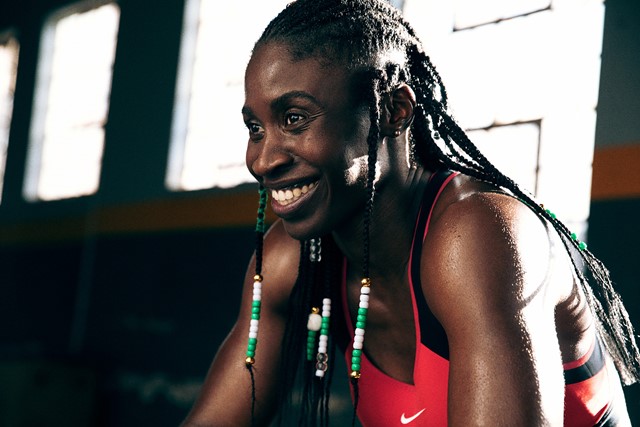Nigerian athlete, Simidele Adeagbo, is just one race away from qualifying for the PyeongChang Winter Olympics, in the sport of skeleton. If she is successful, she will make Olympic history as a member of the first Nigerian contingent to one of the world’s most prestigious competitive sporting events. The skeleton is a winter sliding sport in which a person rides a small sled, known as a skeleton bobsled or sleigh, down a frozen track while lying face down.
Adeagbo, a four-time NCAA All American and triple jump record holder for the University of Kentucky, competed in her last major track and field competition in June of 2008. She had nursed the ambition of competing at the Olympics but was unsuccessful at the trials and thus hung up her boots.

The 36-year old Nigerian athlete however revived her ambition to compete at the Olympics about 10 years later. Her journey to a possible participation at the PyeongChang Winter Olympics in South Korea commenced in December 2016, when she first heard of the Nigerian women’s bobsled team.
She said: “I read an article about how the women had this audacious goal of becoming Africa’s first-ever bobsled team to go to the Winter Olympics. I was super inspired, and instantly thought, I wonder if I could be a part of that? So, when I saw that, I was thinking, maybe they need a fourth person and maybe that fourth person could be me because there’s a history of track and field athletes going into bobsled.”
Adeagbo sent a message to the bobsled team inquiring if she could be a fourth member. The team had just three women and from what she knew, bobsled is a four-person sport. The women however replied, informing her that bobsled is a four-person sport for men, but a two-person sport for women. They informed her their team was complete.
Several months later, there was a potential window of opportunity for participation at the winter Olympics. In July 2017, Adeagbo saw an Instagram post announcing trials by the Nigerian Bobsled and Skeleton Federation in Houston, Texas. She then travelled to Houston, arriving in the morning of tryouts and competed in the trials that evening.
A couple weeks later she got a call from the Federation inviting her to come to a camp in Canada to see if she could live up to the potential she showed at the trials. Despite not knowing much about the sports, Adeagbo did so well at those tryouts, leveraging on everything she already mastered back in her track and field days: speed (with a 45-meter sprint), power (through a shot-put throw) and explosiveness (via a standing long jump). The first time she ever touched a skeleton sled was on September 12, 2017.
According to her: “I honestly didn’t know much about the sport, but knew that there was a lot that I could draw from my track and field background to help me succeed in it. You run as fast as you can for about 30 meters to gain momentum before you launch into or onto something. I was able to pick up the push start very, very quickly because I already had that experience with the runway of triple jump. Where I really have the advantage is only for a very short amount of time, four or five seconds of the race. But the track is a mile long, so the race will last another 50 seconds.”
The winter Olympic hopeful who is training without the help of a trainer or coach spends a lot of time in the gym. One thing Adeagbo quickly realized she would need expert help with was footwear. “Footwear is a really, really important component of the sport, because in skeleton you use your feet to steer the sled,” she said. She contacted Tobie Hatfield, a senior director of athlete innovation at Nike, to ask about her options. Hatifeld, who had designed skeleton spikes for Nike athletes in the past said that he’d like to design a shoe for her.
“We had to focus on keeping the athlete warm and dry in very cold and wet conditions. The biggest attribute of the Nike Zoom Slider is to make it very aerodynamic. With speeds around 80 mph, it is imperative that we give the shoes a nice slip-stream through the air, thus why we cover up the laces with a faring and make the heel as round as possible as that is the leading edge down the hill as she slides” Hatfield explained.
He added: “Simi represents what the power of sport can do to move the world forward, and for me, one of the best parts of her journey is getting the opportunity to create and innovate for not only an employee, but a friend. Most of everything is cut, stitched, pressed and injected at Nike’s World Headquarters in Beaverton, Oregon. We make shoes top-to-bottom for athletes all the time.” Hatfield is still working on the final version of the spikes that Adeagbo will wear if she makes it to South Korea.
Reflecting on what could turn out to be a potentially defining moment in the annals of Winter Olympics for African female athletes, Adeagbo stated: “When I retired from track and field, I didn’t expect that I would have a second chance at the Olympics — and I would have never thought that I’d be a winter Olympian. But when I saw the article about the bobsled ladies, it wasn’t so much my personal Olympic dreams that grabbed me, it was more of the meaningful nature of what they were trying to accomplish that really inspired me. “Ultimately, for me, this is about breaking barriers in winter sports. It’s about making history. And leaving a legacy. It’s about moving sport forward. That’s so much bigger than just me being an Olympian.”
Adeagbo is currently ranked 84th in the world. In order to qualify in skeleton for PyeongChang, an athlete has to be the top athlete in the sport from their country and to have competed in five races on three different tracks in the last two seasons.
She will compete in her final qualifying race on January 11, 2018, in Lake Placid, New York. Qualifiers will be announced from January 14 to 16. If she gets it, she will join the three Nigerian women bobsledders who recently became the first athletes from Africa to qualify for the Olympics in the sport, and Nigeria will have its first and biggest-ever Winter Olympics representation in PyeongChang, South Korea.














